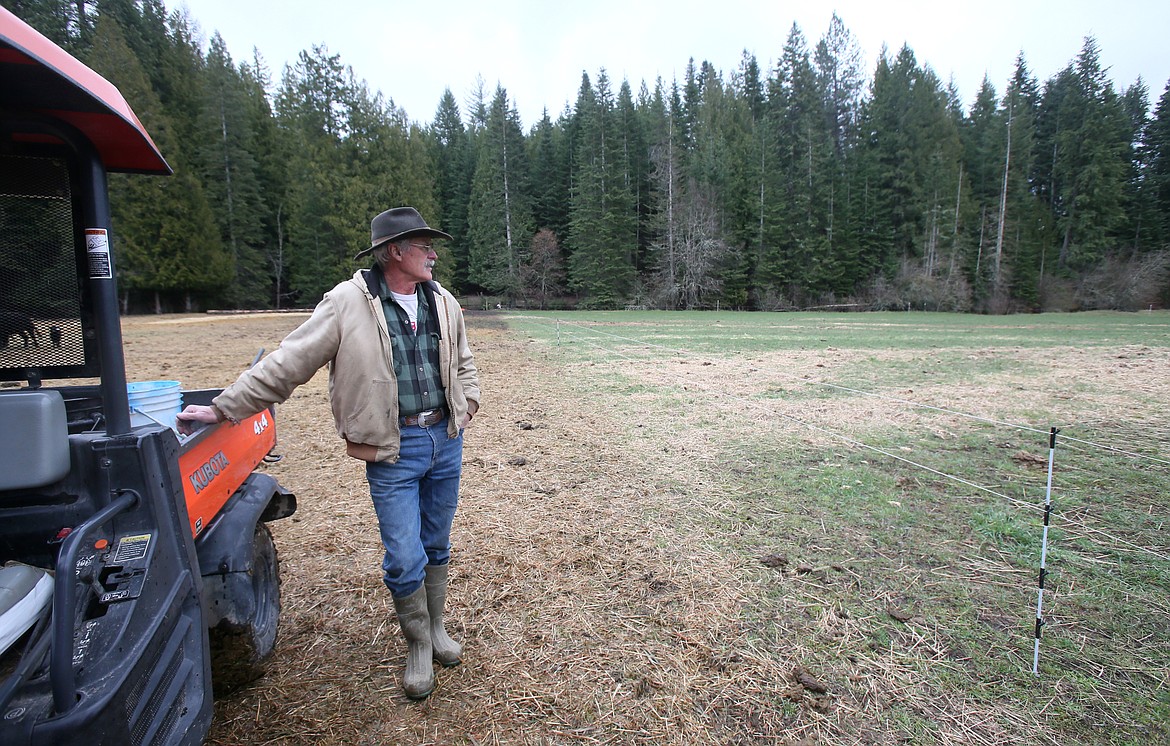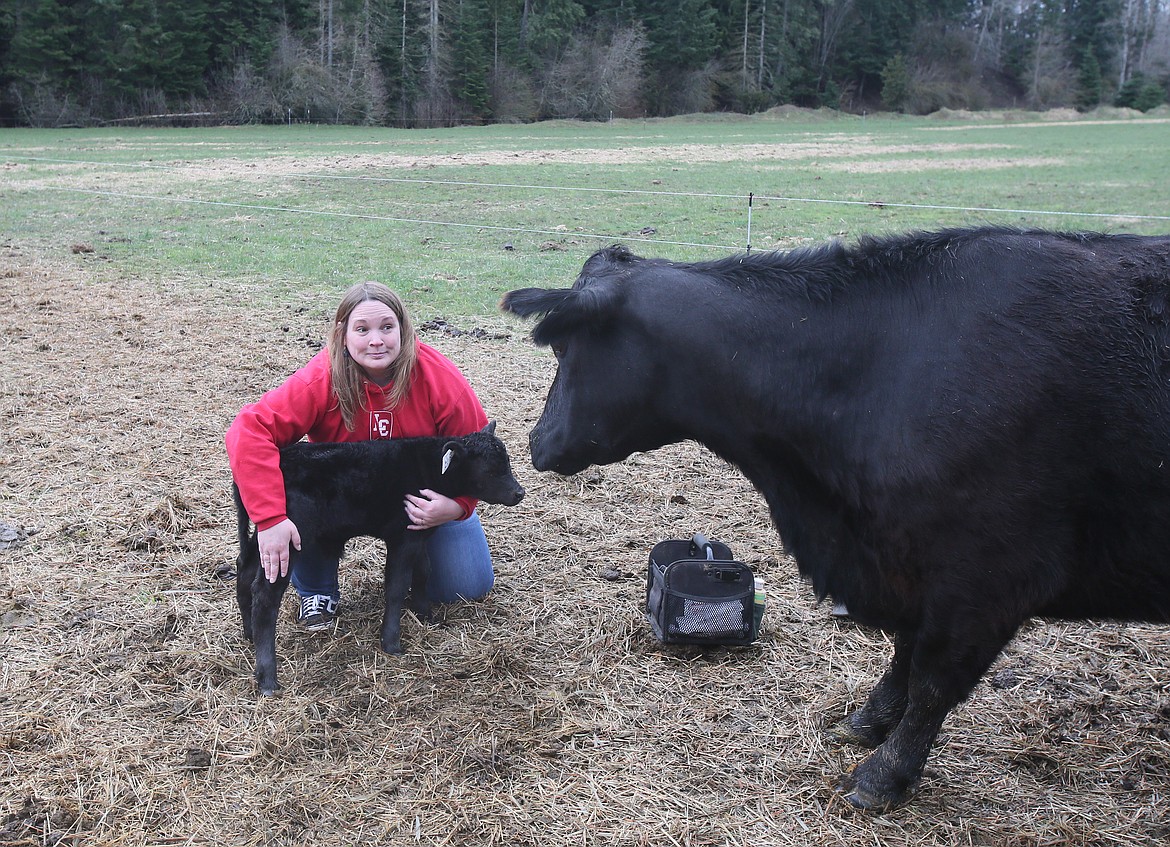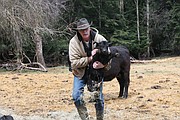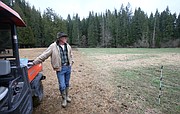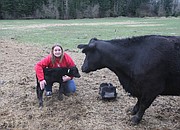Grown with love
DEVIN WEEKS | Hagadone News Network | UPDATED 3 years AGO
Devin Weeks is a third-generation North Idaho resident. She holds an associate degree in journalism from North Idaho College and a bachelor's in communication arts from Lewis-Clark State College Coeur d'Alene. Devin embarked on her journalism career at the Coeur d'Alene Press in 2013. She worked weekends for several years, covering a wide variety of events and issues throughout Kootenai County. Devin now mainly covers K-12 education and the city of Post Falls. She enjoys delivering daily chuckles through the Ghastly Groaner and loves highlighting local people in the Fast Five segment that runs in CoeurVoice. Devin lives in Post Falls with her husband and their three eccentric and very needy cats. | April 22, 2022 1:09 AM
HAUSER — A massive mama cow bellowed as John Mobbs quietly closed in on her four-day-old calf.
In a flash, Mobbs was on the ground, the baby bovine secure beneath him.
"You have to sneak up on them," Mobbs said. "He's quick."
Mobbs banded the testicles, tagged an ear and took measurements around the legs as the mama stood near and kept a keen eye on the baby.
"He's about 43 pounds," Mobbs said, the calf's little face peering out from between his blue-jeaned knees.
There's nothing lazy about the work that goes on at the Lazy JM Ranch in Hauser, a family farm where every day is Earth Day. The ranch's moniker comes from its original cattle brand, which depicts the "J" on its side, called a "Lazy J."
Lazy JM's way of ranching — regenerative — may be a head-scratcher for traditional ranchers. For the Mobbs family, regenerative agriculture is a no-brainer.
"In reality, our grandparents actually farmed that way," Mobbs said. “The animal husbandry I learned from my dad — it was mainly horses, but he converted to livestock. My grandpa taught me how to raise cows and hogs, build pens. They taught me the good stuff."
At Lazy JM Ranch, no antibiotics, hormones or glyphosate herbicides are used. Cattle are moved using a "cell grazing," system so fields are chomped, stomped and fertilized by the cattle themselves — no chemicals needed.
"I'm out there every day," Mobbs said. "I look at the grass, I do the math in my head and I figure, 'This cell needs to be this wide.' I build the cell, I open it and the cows, without saying anything, they're ready to eat. They just walk in. I go out to the field at daybreak, I'll build another cell and in about 25 minutes I'm headed to the house."
These practices make for healthy soil that absorbs water like a sponge, which is crucial during drought conditions.
John's wife of 42 years, Betty, explained that every blade of grass acts as a free solar panel.
"We're not in the cattle business. We're in the solar energy panel business," she said. "After 10 days, our paddocks have all snapped back."
"We're pulling our energy through photosynthesis rather than pulling our energy from the roots," John added. "We're taking the top half off, which is where all the energy is for that animal. It's tender. They love it and their milk production explodes."
This change didn't happen overnight. It was a traditional ranch until John and Betty spoke with subject experts and conducted research on how to better care for their land and animals.
“We don’t want to put nitrogen into the Gulf of Mexico,” Betty said. "We don’t want chemicals in our waterways. When you start researching the dead zones on the Earth and how agriculture has contributed to this, we’re a part of the solution.”
In 2018, John experimented by choosing not to spray or fertilize one field on the 150-acre ranch. Within days, he noticed dung beetles only in that field. Weeds overtook the area for a year. The next, it turned into a dust bowl.
Then, Mother Nature worked her magic.
“I came back the next year and that field exploded,” John said. "It takes time to heal our ground. We decided we’re not going to play this game anymore. We’re going to take care of our livestock, but we’re going to take care of our land and we’re going to do it the best way we can.”
“It’s stewardship of the animals, the plants, the health, the soil,” Betty said. "It just was a natural slide into our own value systems that we have."
Today, on Earth Day, John and Betty are celebrating the 10th anniversary of when they bought the ranch from John's mom. This year is also the golden anniversary of when John's grandparents, Charles and Amelia Jaussaud, and parents, Jack and Leonora Mobbs, originally purchased the farm in 1972 — hence the "J" and "M" in the name.
Lazy JM Ranch is now home to four generations of the Mobbs family. As land is sold and sliced across North Idaho, this family legacy is here to stay.
"My grandfather walked on this ground. I want to make sure that ground stays in the family," John said. "Our goal is to make it to where no one purchases this farm again."
"Our heritage is not for sale," Betty said. "When you have the blessing of four generations working together, you don't take any of it for granted."
What is for sale is grass-finished beef, fresh eggs and other farm stand favorites, grown with love.
Book an appointment to visit Lazy JM Ranch by calling 208-659-9429.
Info: lazyjmranch.com
MORE FRONT-PAGE-SLIDER STORIES
ARTICLES BY DEVIN WEEKS

North Idaho College's Isakson, Haft are Lewis-Clark State College Alumni of the Year
North Idaho College's Isakson, Haft are Lewis-Clark State College Alumni of the Year
They both graduated from Lewis-Clark State College Coeur d'Alene. They both attended Gonzaga University. They both work as deans at North Idaho College. Now, Vicki Isakson and Tami Haft are both the 2025 Lewis-Clark State College Alumni of the year.

Modern-day wizard showcases science sorcery at Bryan Elementary
Modern-day wizard showcases science sorcery at Bryan Elementary
Science is everywhere. Modern-day wizard David Hagerman made this joyfully apparent Thursday as he showcased his scientific sorcery to wow students at Bryan Elementary School. The Emmy-nominated David Hagerman generated laughter and wonder as he used gravity, electricity, chemical reactions and humor to share just how cool science can be.

Retired drill sergeant brings leadership, compassion to Lake City Center
Retired drill sergeant brings leadership, compassion to Lake City Center
It isn't immediately apparent that Lake City Center Executive Director Nancy Phillips is a retired U.S. Army drill sergeant who directed deployment teams in support of overseas operations and spent 20 years in active military service. She smiles and greets patrons by name when they walk in the door. Her voice is gentle and kind, and she is not of large stature. “There’s a picture of me as a drill sergeant,” she said Monday, beginning to smile. “I look like a 12-year-old.”



